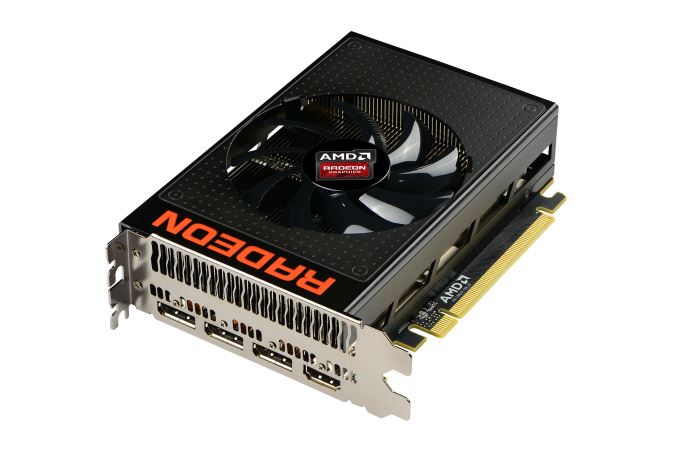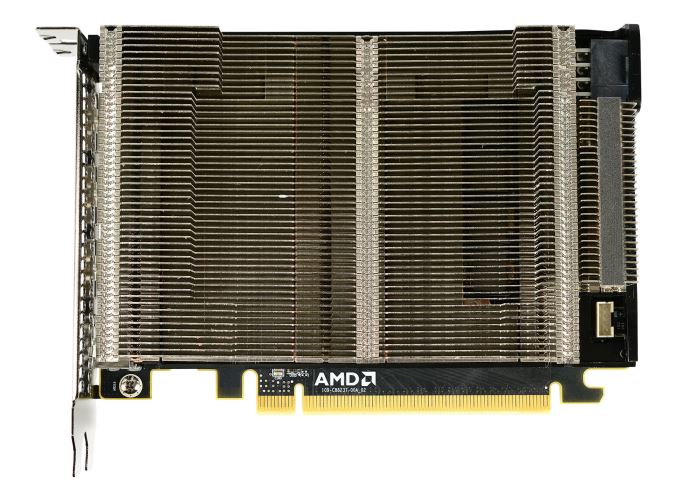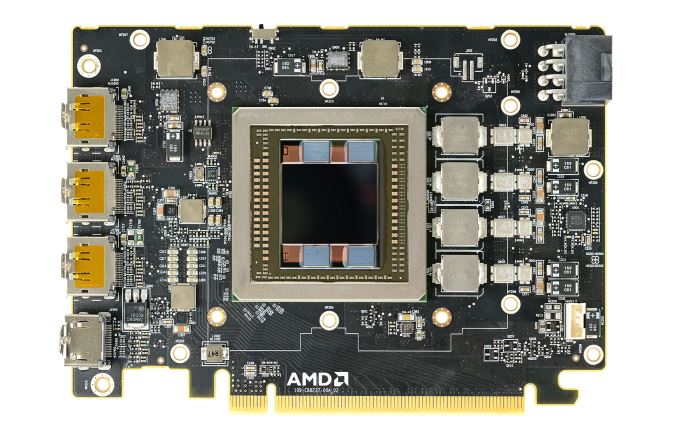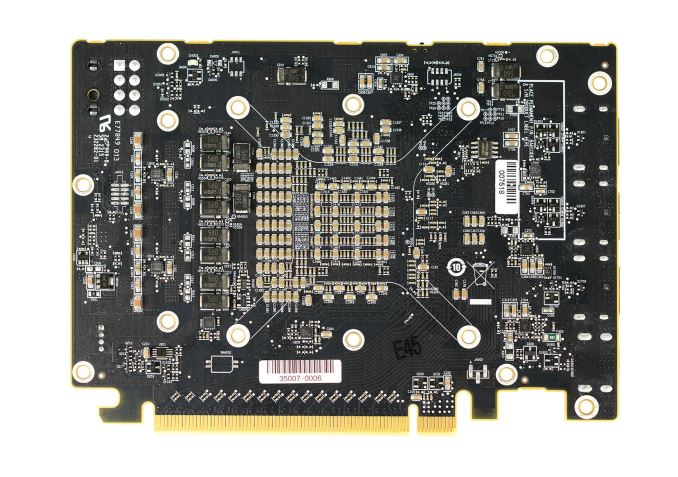The AMD Radeon R9 Nano Review: The Power of Size
by Ryan Smith on September 10, 2015 8:00 AM ESTMeet The Radeon R9 Nano
6 inch video cards are by no means a new thing in the GPU space, however these are traditionally lower-end products that need neither a large cooler nor an extensive power delivery system. As a result the R9 Nano is something of an interesting aberration, packing a lot more power and a lot more technology into half a foot of video card than what we normally see.
Starting as always from the top, the R9 Nano measures 6” long, which is actually a bit shorter than the full length the Mini-ITX standard allows. Responsibility for cooling the card falls to the R9 Nano’s new open air cooler, an aggressive design that has been specifically tailored to allow the card to effectively dissipate 175W of heat in such a small space.
The overall design of the R9 Nano’s cooler is best described as a combination open-air and half-blower hybrid. The design is technically open-air, employing a single axial fan to cool the card. However with only a single fan AMD has been able to align the heatsink fins horizontally and then place the fan in the center of the heatsink. The end result is that roughly half of the heat produced by the card is vented outside of the case, similar to a full blower, while the other half of the heat is vented back into the case. This reduces (though doesn’t eliminate) the amount of hot air being recycled by the card.
The heatsink itself is composed of aluminum and runs virtually the entire length of the card. This is technical a two-piece heatsink, with the primary heatsink composing the bulk of the card, while a much smaller secondary heatsink it found towards the far end of the card and mounted on top of a heatpipe.
Drilling down, we find that the primary heatsink is fed by a combination vapor chamber and heatpipe design. A copper vapor chamber serves to draw heat away from the Fiji GPU and HBM stacks, and then heatpipes are used to better distribute heat to the rest of the heatsink. The use of a vapor chamber in the R9 Nano makes a lot of sense given the fact that vapor chambers are traditionally the most efficient heatsink base type, however the R9 Nano is also unique in that we typically don’t see vapor chambers and heatpipes used together. Other designs such as the high-end GeForce series use a single large vapor chamber across the entire heatsink base, so among reference cards at least the R9 Nano stands alone in this respect. In this case given AMD’s design goals for size and noise, a vapor chamber will play a big part in helping the small card effectively and quietly dissipate 175W.
As for the physical PCB itself, as we can see AMD made it a relatively packed card in order to get the R9 Nano down to 6 inches. Compared to the R9 Fury X reference board, the biggest change here is that AMD has removed a fair bit of power circuitry to save space. By our count there are 4 VRM phases to feed the Fiji GPU, as opposed to the 6 found on R9 Fury X. Power delivery is handled by a single 8-pin PCIe power socket, which is becoming increasingly common, replacing the 2x 6-pin setup for 150W-225W cards.
Meanwhile to further shrink the overall PCB footprint, AMD has moved some of the remaining power delivery circuitry to the back of the card. The front of the card still contains the inductors and heat-sensitive MOSFETs, while a number of capacitors are on the rear of the card (and is why you won’t find a backplate).
Finally, for display I/O R9 Nano is unchanged from R9 Fury X. This means we’re looking at a DVI-free design, with 3x DisplayPort 1.2 and 1x HDMI 1.4 port all along a single row of the I/O bracket. Buyers looking to put together HTPCs will want to be especially mindful of the HDMI 1.4 port; while it's not necessarily a deal-breaker, it does mean that the R9 Nano can't fully drive 4Kp60 TVs, which are slowly but surely becoming more common.
Overall AMD is rather confident in their design for the R9 Nano. The heatsink is built to efficiently dissipate more heat than the 175W the card requires (despite the small size), and as a result we never see the R9 Nano thermally throttle under normal operation. The card’s thermal throttle point is 85C, and in our testing the card never passed 75C, exactly as AMD promised us. What ends up limiting the R9 Nano’s performance then is exactly as expected: the power throttling.
















284 Comments
View All Comments
Gigaplex - Thursday, September 10, 2015 - link
Not quite. They didn't actually lower voltages.Shadowmaster625 - Thursday, September 10, 2015 - link
OC load power consumption under Crysis 3 is the same as stock load power consumption. What went wrong there? Is the card really not overclocking or do you have the wrong data?Communism - Thursday, September 10, 2015 - link
Powertune is the limiter, which sets a soft long wattage limit.In other words, you can overclock the card to 9000 mhz and it would still use the same long term max power.
What's happening is that the card is simply throttling even more heavily compared to stock clocks.
Ryan Smith - Thursday, September 10, 2015 - link
Power consumption went up by 59W: http://images.anandtech.com/graphs/graph9621/77410...Shadowmaster625 - Thursday, September 10, 2015 - link
GTX980 crushes this thing. You can easily fit a GTX 980 into a Corsair Air 240. There really isnt much to be gained by going smaller than a Corsair Air 240. If AMD really wants to go after mini pc market, then they need to strip out 10% of those compute cores, replace them with carrizo modules, quadruple the amount of HBM, and replace one of the HBM chips with a flash chip. They could create an entire motherboard that would be roughly the size of that Nano pcb. Slap it into a tiny case and boom you have a product no one can match.jardows2 - Thursday, September 10, 2015 - link
Like I mentioned earlier. This card is for a niche boutique build. I wouldn't buy one for myself, as I don't need the power in such a small product. But general mass consumers are well known for buying something for looks rather than practicality. A tiny computer that is only big enough to fit the Nano? There are people who would spend the money to buy it!medi03 - Friday, September 11, 2015 - link
"R9 Nano demonstrates slightly better performance than GTX 980 –around 5% at 2560x1440"Crushes, eh?
Peichen - Thursday, September 10, 2015 - link
What a fail. More than twice as expensive as GTX970 mini but only 20% faster and runs hotter, louder and hungrier as well. The FURY chips are very inefficient compares with Nvidia's offerings and I am not sure how many people would pay $370 more just for 20% in an ITX setup. Most ITX case can take 10" card as well.palindrome - Thursday, September 10, 2015 - link
You answered your own question. The card is 20+% faster than the closest competitor in this space.TheinsanegamerN - Thursday, September 10, 2015 - link
so who would pay twice as much for 20% more performance? not many, seeing as the 970 is good enough for 1080p and is still surprisingly good at 1440p.